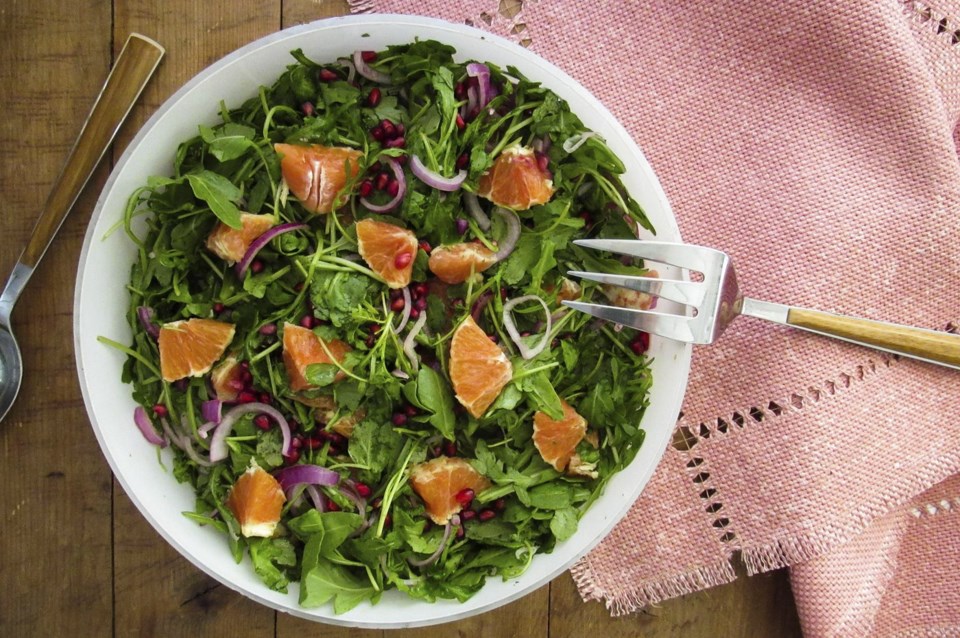, the Jewish New Year, has many wonderful foods associated with it. Apples, honey, , — and shining on this list are pomegranates, that one-of-a-kind beautiful, mythical, symbolic and even Biblical fruit.
In the Sephardic tradition, pomegranates are celebrated as part of the Rosh Hashanah meal as a symbol of abundance, knowledge and righteousness. The fruit's numerous seeds led some to say that the seeds corresponded to the 613 commandments of the Torah. (In fact, most pomegranates have somewhere between 400 and 800 seeds, but it’s a lovely allegorical notion).
On the table, a pomegranate-shaped dish might hold honey for apples to be dipped in. Yemenite Jews in Israel might have a pile of pomegranates as a centerpiece during the holiday meal.
Pomegranates are used in savory and sweet dishes, and are popular in Israeli and other Middle Eastern cooking, as well as in Mediterranean, Indian and African food. Pomegranate juice is also popular, used in cooking and available bottled for straight-up drinking and use in and .
The seeds and juice are both sweet and tart in flavor. Like citrus fruit, they taste refreshing and can be bold in flavor. And pomegranates are packed with nutrients.
You can add them into salads, rice and grain dishes, or stir them into yogurt. Sprinkle them on baked eggplant and other roasted vegetable dishes. Or incorporate them into tarts, cakes, scones and chocolate desserts.
This Rosh Hashana, use pomegranate seeds to provide a little flair and color to the holiday dinner by adding them to a simple salad, like the one below.
How to remove pomegranate seeds from the fruit
The biggest obstacle to enjoying them on the regular during their cold-weather season is getting those bountiful seeds from the leathery skin and clingy white internal membranes. You need to do a little work cutting through the thick exterior and extracting the seeds without letting any of the juice stain your clothes, countertop or dish towels.
Some supermarkets or specialty markets sell containers of just the seeds. If you are buying the seeds already removed from the fruit, make sure the little arils are bright red and firm, not shriveled, soft, or brownish in color.
If you're buying whole pomegranates, choose ones that are firm and bright in color. Firm and heavy indicates that the arils/seeds are filled with lots of juice. Make sure the fruit is free of brown spots and bruises.
Before beginning, grab an apron to protect your clothes (or wear an old, unloved shirt) and, if possible, a plastic (not wood) cutting board to prevent the juice from staining your cutting surface. If you want to prevent any temporary staining of your hands, wear some cooking-compatible plastic or rubber gloves.
Start by cutting off a thin slice of the fruit's bottom so it can stand securely. Then cut around the crown (the end with the “blossom” sticking out) at a slight angle into the top of the fruit so that the top comes off and there is a slight dip into the pomegranate. Use your knife and from top to bottom cut just through the thick skin but not into the seeds. Make five more cuts at fairly equal segments so there are a total of six cuts/sections. Pry open the pomegranate with your fingers; it should fall into six open sections.
Fill a large bowl with cold water. Submerge the sections and gently separate the seeds from the white membranes. As the seeds separate from the fruit, they will sink to the bottom, while the white membranes will float to the top. Then simply toss the skin, skim the membranes from the water, drain seeds in a strainer, and you are ready to roll.
Arugula, Orange and Pomegranate Salad
Ingredients
For the lemon vinaigrette:
1 large shallot, thinly sliced
2 tablespoons fresh lemon juice
1 tablespoon rice or white wine vinegar
3 tablespoons olive oil
Kosher salt and freshly ground pepper to taste
For the Salad:
8 cups baby arugula
1 small red onion halved and very thinly sliced
2 oranges, preferably cara cara or blood oranges
1 cup pomegranate seeds
Directions
Make the vinaigrette. In a small container, combine the shallots, lemon juice, rice vinegar, olive oil, salt and pepper. Shake to blend.
Place the arugula in a large serving bowl with the onion. Peel the oranges, and use a paring knife to remove all of the white pith from the outside of the fruit. Separate the orange slices, and cut each slice into 4 pieces. Add these to the bowl.
Pour the dressing on the salad, and toss to combine. Scatter the pomegranate seeds over the top and serve.
—-
Katie Workman writes regularly about food for The Associated Press. She has written two cookbooks focused on family-friendly cooking, “Dinner Solved!” and “The Mom 100 Cookbook.” She blogs at She can be reached at [email protected].
___
For more AP food stories, go to
Katie Workman, The Associated Press



